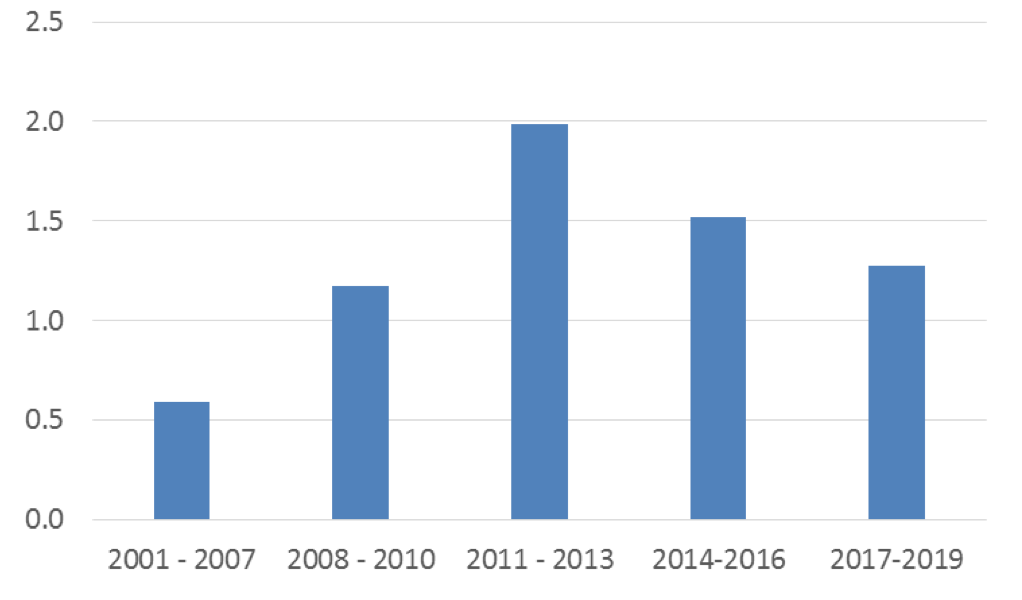
Global Fund round five: Australia keeping up
By Camilla Burkot and Ashlee Betteridge
22 September 2016
Over the weekend, leaders and foreign ministers met in Montreal, Canada, for the fifth replenishment conference for the Global Fund to Fight AIDS, Tuberculosis and Malaria.
Global Citizen threw a big concert, Bill Gates hugged the very beautiful Canadian PM Justin Trudeau, Bono gave a keynote, and at the end of it all, the Global Fund had raised US$12.9 billion in pledges.
This is nearly a billion dollars more than what was raised in the fourth replenishment, and just shy of the Fund’s $13 billion target for 2017-19, so a good outcome. This echoes the outcome for Gavi, the Vaccine Alliance, in January 2015 – Gavi also met its funding target of US$7.5 billion over five years.
Australia pledged A$220 million, a nominal increase of 10 percent on our last pledge, as you can see below in the chart from the Australian Aid Tracker.
Given the massive cuts to Australian aid since the last Global Fund replenishment in 2013, this is a good result for the Fund. Australia committed 10% more, and overall the Global Fund raised about 10% more. It is a sign that the government continues to support the Global Fund’s work. Foreign Minister Julie Bishop notes that the Global Fund is a “valued partner in Australia’s efforts to improve regional health security” in the press release announcing the pledge.
It is also perhaps a testament to the strong advocacy that has been undertaken on behalf of the Fund in Australia over the past few years – leader Mark Dybul has made a couple of visits, including to deliver the 2016 Mitchell Oration at our Centre. The hard yards put in by Fund advocates on Capital Hill seem to have paid off; over half of Australia’s federal representatives signed letters calling for increased support to the Global Fund ahead of the Montreal meeting. And there is also that TB crisis just next door in PNG, another reason to act.
Australia’s contribution hasn’t quite won over everyone though – the Campaign for Australian Aid rated it as a ‘B+’ with plenty of room for improvement. It, and other campaigners, had argued that $300 million would have been a fair share for Australia in this replenishment.
Australia’s pledge places us 10th among country donors to the Global Fund, or the 12th largest contributor overall (the Bill & Melinda Gates Foundation came in at 7th place, followed by the European Commission). Our country ranking has not changed since the 2014-16 round. (As the Australian Aid Tracker notes, from 2008 to 2010 Australia was the 14th largest government donor to the Global Fund. Between 2011 and 2013, we were the 11th largest.)
Despite the nominal increase and holding our rankings, $220 million represents a drop in our percentage share of the total replenishment – particularly due to the weak Australian dollar.
Figure 2: Australia’s contribution as a percentage of Global Fund replenishments
But our contribution does represent an increase in the percentage share of our aid that we are using to support the Fund. The table below shows our Global Fund pledges for each three-year round since 2011 as a percentage of total Australian aid over the period. (Note that Australian aid is budgeted by financial year, so the table makes an assumption that Global Fund contributions will come from aid budgets announced after the pledge announcement, even though replenishments are tied to calendar years).
Table 1: Australia’s Global Fund contribution as percentage of Australian aid
In terms of percentage increases over the last replenishment, Belgium topped DAC donors with a 50% increase in funds pledged (US$57m), and Italy increased its contribution by 40% in 2016 with a contribution of US$156m (Figure 3). In terms of volume, the largest single contribution came from the US, which pledged a two-for-one donation up to US$4.3 billion (representing a third of the total replenishment amount pledged), and new DFID Secretary Priti Patel announced a contribution of US$1.4 billion (£1.1bn). The UK also promised to match private sector pledges up to an additional £200m. The UK’s contribution did, however, come with an as-yet-unspecified ‘performance agreement’ requirement that has been described as ‘perplexing’ – but is expected to become the standard with DFID’s multilateral partners.
Figure 3: Top 15 donors to 2017-19 Global Fund replenishment
Note: percentage changes are calculated using source currency of pledges. See data here.
While most donor countries’ contributions increased over the previous replenishment period, there were some outliers. The 2016 pledges by the Netherlands (US$174m) and Denmark (US$44m) represent decreases of about 16% and 40%, respectively (calculated using source currency). New Zealand’s showing was also disappointing. Though it was one of the first countries to make a pledge, back in April, it contributed only $1m. One has to wonder whether the early announcement was a strategic choice to avoid the limelight: this is the same amount that several implementing countries pledged, including Zimbabwe and first-time donors Senegal, Togo, and Benin.
Alongside them, Kenya made a US$5m pledge, in addition to the domestic funding it allocates in excess of US$50m. South Africa also donated US$5m, a 233% increase on its previous pledge. Most of the non-DAC donors are African countries, though. India and China have respectively pledged US$20m (a 48% increase over its last contribution) and US$18m (a 20% increase). A number of Middle Eastern countries also made pledges, including Kuwait (US$5m), Qatar (US$10m), and Saudi Arabia (US$15m). Again, this mirrors the situation with the most recent Gavi replenishment, in which China, Oman, Qatar and Saudi Arabia made pledges for the first time.
Non-government organisations and the private sector showed their increasing willingness to chip in too, with a total of US$250m raised this replenishment round – more than double that raised over the last three years. (This is in addition to the US$600m pledged by the Bill & Melinda Gates Foundation). Only a handful of donors have so far been named, though; among them, HIV/AIDS focused partnership Project (RED) leads with a pledge of US$100m, with UK-based charity Comic Relief coming in a distant second with US$12.75m. Several banks and at least one pharmaceutical company – Japanese firm Takeda – are also identified on the Global Fund’s press release, but without figures attached.
Camilla Burkot and Ashlee Betteridge are Research Officers at the Development Policy Centre.
About the author/s
Camilla Burkot
Camilla Burkot was a Research Officer at the Development Policy Centre, and Editor of the Devpolicy Blog, from 2015 to 2017. She has a background in social anthropology and holds a Master of Public Health from Columbia University, and has field experience in Eastern and Southern Africa, and PNG. She now works for the Burnet Institute.
Ashlee Betteridge
Ashlee Betteridge was the Manager of the Development Policy Centre until April 2021. She was previously a Research Officer at the centre from 2013-2017. A former journalist, she holds a Master of Public Policy (Development Policy) from ANU and has development experience in Indonesia and Timor-Leste. She now has her own consultancy, Better Things Consulting, and works across several large projects with managing contractors.



